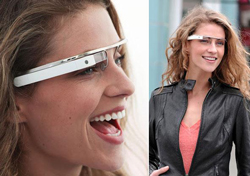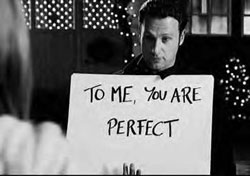Google Unveils its Augmented Reality Glasses

In 1991 when Arnold Schwarzenegger walked into the bar in the beginning of Terminator 2: Judgement Day, we all glimpsed at what augmented reality could be like. In a crimson red background, the cyborg’s biometric eyes studied the people in the bar using digitized checklists of countless algorithms, analyzing each individual from head to toe until the Terminator found his match and with a probability reading of 0.99, saying “I need your clothes, your boots, and your motorcycle.”
Now in 2012, 21-years-later, Google has announced its own endeavor, Project Glass, to bring to fruition the augmented reality optics Generation Y had always grown up fantasizing about, from futuristic movie series such as Star Wars and Terminator.
The prototype glasses that Google publicized a few weeks ago marked the company’s first steps in the ephemerally uncharted territory of wearable computing. Presently under development in Google’s secret research lab located near Mountain View, California, the glasses “can stream information to the lenses and allow the wearer to send and receive messages through voice commands. There is also a built-in camera to record video and take pictures,” according to the New York Times.
Isabelle Olsson, an industrial designer on the Project Glass team, said on the Project’s website, “A group of us from Google started Project Glass to build this kind of technology, one that helps you explore and share your world, putting you back in the moment.”
A video entitled “Project Glass: One day…” released by Google, which sparked over 13 million views on YouTube in only two weeks, shows the point of view of a man’s own eyes seeing through the glasses on a regular day.
As he puts on the glasses after waking up in the morning, a series of circular icons typically on the home screen of a contemporary smartphone appear in thin air. The icons are dismissed and music begins playing as the man begins to make coffee and a sandwich for breakfast. As he stares out the window at the blue sky across the high-rises of New York City, a small cloud labeled with “58 degrees” and “10 percent chance of rain” appears.
Taking a bite out of his sandwich, he responds hand-free using his voice to a visualized text message from a friend to rendezvous at a bookstore. As he walks around the Big Apple, following a voice-guided walking route devised by a GPS system after finding out that the subway was down, he talks to himself, setting reminders to see a concert from an advertisement he sees on a wall, checks into Google+ at a coffee truck, snapshots artful graffiti by simply saying “Take a photo of this” and shares that picture with his circles on Google+ within seconds.
Towards the end of the video, he accepts a call from his girlfriend, and as if it was a Skype video call, her face appears in the bottom of his field of vision in a rectangular box. Then, the video output is reversed and she is seeing through his eyes at the magnificent sunset across the Atlantic Ocean.
Maham Ayub, a freshman who is double majoring in English and Education, thinks that “It’s fascinating to see how much the world is changing. I’m really interested to see what the future holds in store for us. Even though the glasses seem pretty convenient and cool, they may be taking over a lot of the portable technology we now have.”
According to the New York Times, Project Glass could h y p o t h e t i cally become Project Contact Lens. Dr. Babak Parviz, an associate professor at the University of Washington who specializes in bionanotechnology, which is the amalgamation of tiny technologies and biology, has engineered a contact lens with an embedded optoelectronic infrastructure that can display pixels directly on the eye itself.
Dr. Jia Luo, chemistry professor, said, “I am very excited to see that bio-nanotechnology will help to bring ‘Terminator eyes’ into reality in the near future. It’s truly remarkable that scientists have demonstrated incorporating display and battery-free wireless communication circuits into contact lens.”
“We think technology should work for you, to be there when you need it and get out of your way when you don’t,” said Olsson.
In response to the concerns of many people that already wear prescription glasses, Isabelle Olsson responded on the Project’s website, “We ideally want Project Glass to work for everyone, and we’re experimenting with designs that are meant to be extendable to different types of frames. Many of our team members wear glasses, too, so it’s definitely something we’re thinking about.”
Project Glass has inevitably opened up oceans of challenges centered about privacy, public safety, and practicality. As the contemporary debate between the increasing trends in the ubiquity of technology versus decreasing critical thinking skills amongst today’s students rage forward, the advent of Google glasses may inadvertently tip the scales to one side.
Whether Project Glass brings forth the greatest advancement we have ever seen or completely destroys the remainder of human socialization left from the advent of smartphones, we will see soon enough.
“Looking back over the past decade and having seen physical human interactions diminish and be replaced by texting, live chat, and Facebook, I think Google has found a way to get people sucked up and lost in a virtual world,” said Conrad Sawicki, third-year chemistry major.
Try as you might, you would be hard pressed to completely deny the close relationship between the Google glasses and the headsets people wore in Wall-E.
IMAGE TAKEN from nytimes.com



